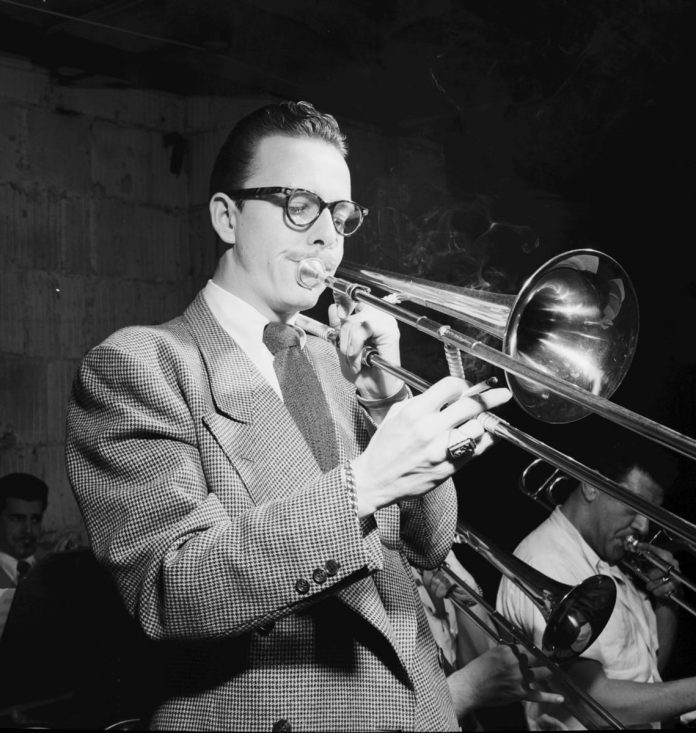Kai Winding was born in Aarhus, Denmark, 18 May 1922, and emigrated with his family to the USA in 1934. He was largely self-taught and began his professional career with the Sonny Dunham and Alvino Rey bands before spending three years with the US Coast Guard from 1942.
His debut as a leader took place in December 1945 with Shorty Rogers, Stan Getz and Shelly Manne when they recorded four titles for Savoy under the title Kai’s Cats (Masters Of Jazz MJCD117). One of the tracks – Loaded – was by an obscure Washington D.C. pianist called Bernie Miller (1919-1945). A year earlier Boyd Raeburn’s orchestra had recorded another of his originals – Bobby Socks – which became better known as Bernie’s Tune.
In February 1946 Winding joined Stan Kenton’s orchestra, which had been selected as the band of the year by Look magazine and was breaking records everywhere it played. His first solos four months later were on Rika Jika Jack (a forgettable June Christy feature) and Artistry In Boogie (Mosaic MQ10-163).
Even though he was only with Kenton for about a year his influence was immense. He created a distinctive section sound by persuading his colleagues to produce a lip instead of a slide vibrato. Milt Bernhart said “Kai Winding was the lead trombone and without question the most important player in the band at that time”. Kenton agreed – “Kai changed the whole goddam conception of the band and my whole way of thinking”. He brings something special to his features with the band on Capitol Punishment, Artistry In Bolero, Yesterdays, Ecuador, I’d Be Lost Without You, Collaboration and Machito (Mosaic MQ10-163). When they were appearing at the Paramount in NYC he heard J.J. Johnson for the first time at the Famous Door with Charlie Parker. He told Milt Bernhart that J.J. left him speechless.
Leaving Kenton he worked with Charlie Ventura for a while in 1947 and they were recorded at the Hotel Sherman, Chicago with singer Buddy Stewart. The popular East Of Suez was introduced on the booking and Winding thrives in what was a forerunner to Ventura’s Bop For The People ensemble (Properbox 41CD).
In the late 40s he had a group that included Brew Moore, Gerry Mulligan and George Wallington that often worked at the Royal Roost and Bop City. They recorded 14 titles on obscure labels which are difficult to obtain now but would perhaps make a very welcome reissue project for the Fresh Sound label.
In the early 50s Kai combined radio and television studio work with occasional bookings at Birdland with Red Rodney, Zoot Sims, Brew Moore and Bill Harris. He was also briefly with Woody Herman in 1953 and he can be heard on the memorable Four Others by Jimmy Giuffre, a feature for the trombone section which included Urbie Green, Frank Rehak and Vern Friley (Discovery DSCD 944).
Joining with J.J. Johnson in 1954 was a chance to escape the routine of studio work and return to full-time jazz. Together Jay and Kai created stimulating small-group performances with tightly arranged ensembles usually voiced in unison or thirds. A variety of mutes sometimes came into play for extra colour on It’s Alright With Me, I Concentrate On You, Just For A Thrill and especially The Whiffenpoof Song. Producer George Avakian was particularly impressed by their studio performance on Whiffenpoof: “It’s a wild sight to see them each keeping pace with the lightning routine of mute up, mute in, blow, mute out, mute down, new mute up, mute in, blow and so on. Never once did they fluff a phrase.” (Lonehill Jazz LHJ 10179).
After two years together they felt that all the possibilities of a two trombone line-up had been exhausted so they decided to call it a day in 1956 but not before one of their last albums where six other trombones were added to the mix with particularly notable performances on Night In Tunisia, The Surrey With The Fringe On Top and The Peanut Vendor. (Columbia COLCD 480990).
Years later J.J. had this to say: “I have a very fond recall of the Jay and Kai cycle. Kai was a super jazz trombonist who always performed with wit, killer chops, quasi reckless abandon yet with intelligent sophistication. He was a complete musician and total artist plus a fun, fun dude to be with or to work with.”
1956 was the year jazz journalist Leonard Feather invited 100 leading musicians from Louis Armstrong to Lester Young to nominate their favourite instrumentalists. J.J. Johnson came top in the trombone section followed by Bill Harris, Jack Teagarden, Bob Brookmeyer, Tommy Dorsey, Lawrence Brown, Jack Jenney, Vic Dickenson, Kai Winding, Trummy Young, Jimmy Harrison, Frank Rosolino and Earl Swope.
Read part one of J.J. Johnson and Kai Winding: the early years
















